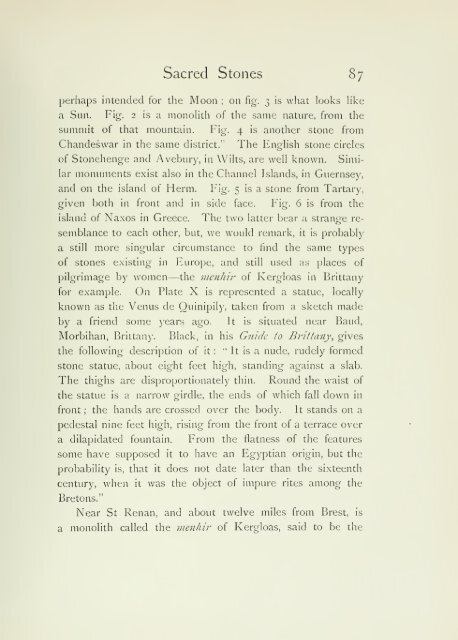Download Ebook - Free History Ebooks
Download Ebook - Free History Ebooks
Download Ebook - Free History Ebooks
Create successful ePaper yourself
Turn your PDF publications into a flip-book with our unique Google optimized e-Paper software.
perhaps intended for the Moon ;<br />
Sacred Stones 87<br />
on<br />
fig. 3<br />
is what looks like<br />
a Sun. Fig. 2 is a monolith of the same nature, from the<br />
summit of that mountain. Fig. 4 is another stone from<br />
Chandeswar in the same district." The English stone circles<br />
of Stonehenge and Avebury, in Wilts, are well known. Simi-<br />
lar monuments exist also in the Channel Islands, in Guernsey,<br />
and on the island of Herm. Fig. 5 is a stone from Tartary,<br />
given both in front and in side face. Fig. 6 is from the<br />
island of Na.xos in Greece. The two latter bear a strange re-<br />
semblance to each other, but, we would remark, it is probably<br />
a still more singular circumstance to find the same types<br />
of stones existing in Europe, and still used as places of<br />
pilgrimage by women—the menhir of Kergloas in Brittany<br />
for example. On Plate X is represented a statue, locally<br />
known as the Venus de Ouinipily, taken from a sketch made<br />
by a friend some years ago. It is situated near Baud,<br />
Morbihan, Brittan)-. Black, in his Guide to Brittany, gives<br />
the following description of it : " It is a nude, rudely formed<br />
stone statue, about eight feet high, standing against a slab.<br />
The thighs are disproportionately thin. Round the waist of<br />
the statue is a narrow girdle, the ends of which fall down in<br />
front; the hands are crossed over the body. It stands on a<br />
pedestal nine feet high, rising from the front of a terrace over<br />
a dilapidated fountain. From the flatness of the features<br />
some have supposed it to have an Egyptian origin, but the<br />
probability is, that it does not date later than the sixteenth<br />
century, when it was the object of impure rites among the<br />
Bretons."<br />
Near St Renan, and about twelve miles from Brest, is<br />
a monolith called the menhir of Kergloas, said to be the

















